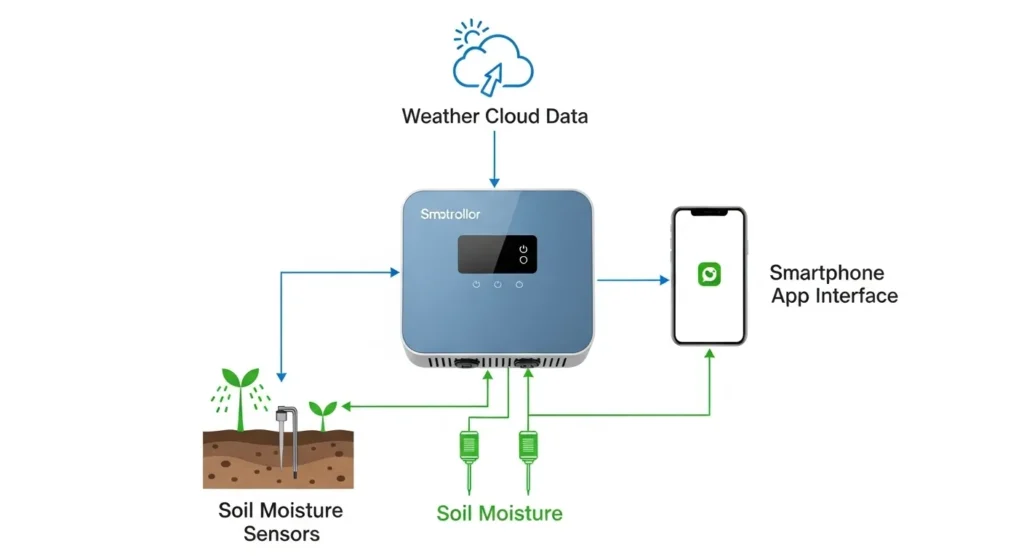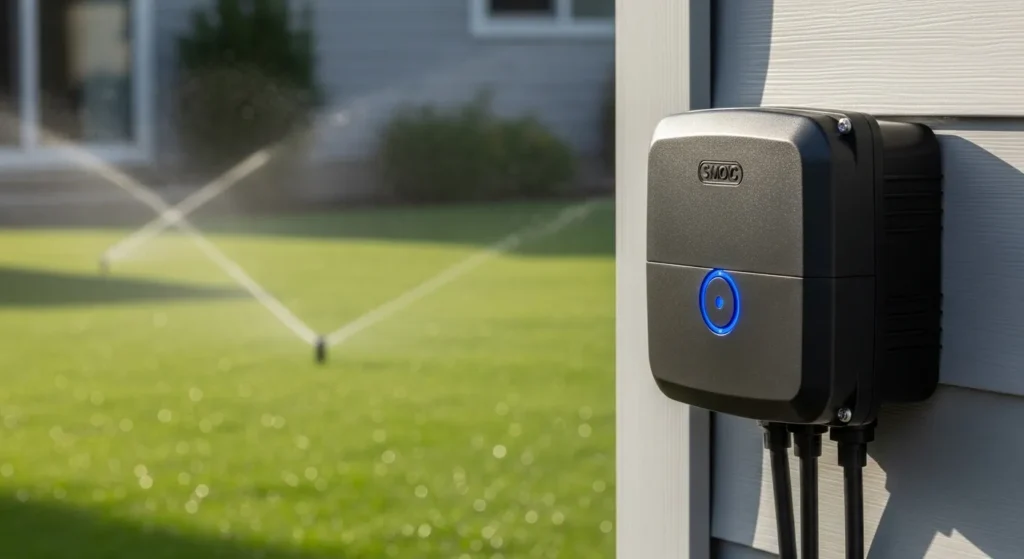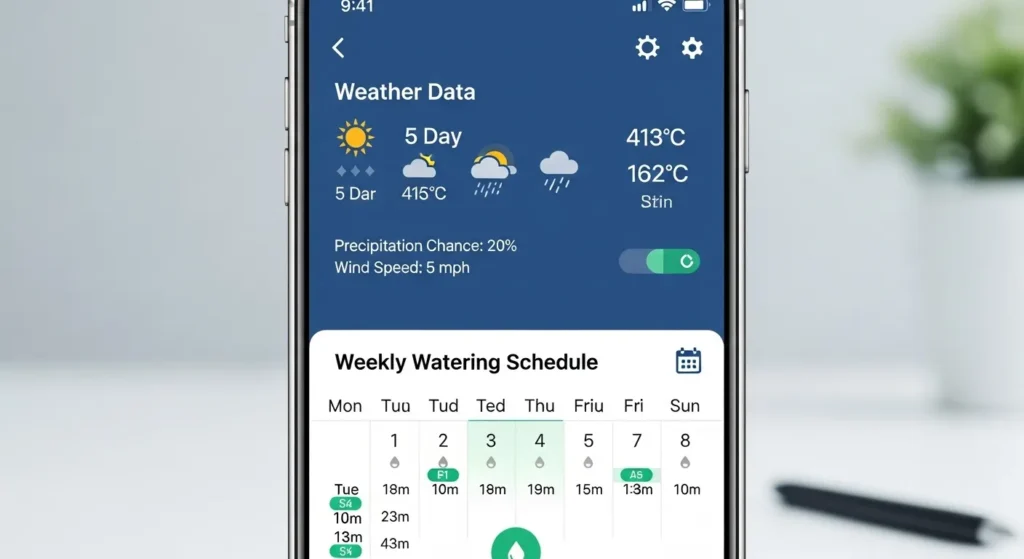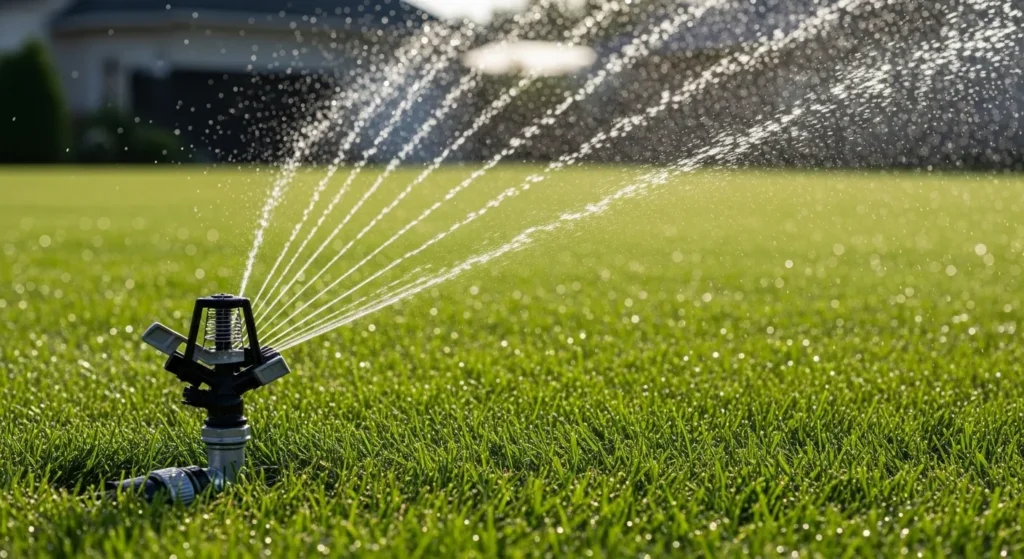Smart irrigation systems are changing how homeowners maintain their lawns. These advanced watering systems use weather data, soil sensors, and mobile apps to deliver the right amount of water at the perfect time. Smart irrigation controllers can help homeowners achieve water savings of 20% to 50%, making them both eco-friendly and budget-smart choices for modern lawn care.
What Are Smart Irrigation Systems?
Smart irrigation systems automatically control when and how much water your lawn receives. Unlike traditional sprinkler timers that water on fixed schedules, these systems adjust watering based on real conditions. They deliver only the exact amount of water needed to landscapes at the exact right time.
The system includes smart controllers that connect to your home’s Wi-Fi network. These controllers gather data from weather stations, soil moisture sensors, and your smartphone app. When rain is forecast, the system skips watering. During hot, dry periods, it waters more frequently.

How Smart Irrigation Systems Work
Smart irrigation systems operate through three main components:
Weather-Based Monitoring
The controller connects to local weather stations and satellite data. It tracks temperature, humidity, wind speed, and rainfall. When rain is on the horizon, the system automatically dials down or postpones watering to save water and prevent overwatering.
Soil Moisture Detection
Advanced systems include soil sensors that measure moisture levels in your lawn. These sensors send data to the controller, which adjusts watering schedules based on actual soil conditions rather than guesswork.
Mobile App Control
Most systems come with smartphone apps that let you monitor and control watering from anywhere. You can adjust schedules, check system status, and receive alerts about watering cycles or system problems.
Types of Smart Irrigation Controllers
Weather-Based Controllers
These controllers use local weather data to adjust watering schedules. They’re the most common type and work well for most homeowners. Popular brands include Rachio, Rain Bird, and Orbit.
Soil Sensor-Based Controllers
These systems use buried sensors to measure soil moisture directly. They provide more accurate watering but cost more to install. Brands like Smart Rain and HydroPoint offer these advanced systems.
Hybrid Systems
Some controllers combine weather data with soil sensors for maximum accuracy. Systems like Irriggreen use precision zone mapping and live weather input to keep lawns green without waste.

Benefits of Smart Irrigation Systems
Water Conservation
Controlled research studies indicate substantial water savings anywhere from 30 to 50 percent compared to traditional systems. This conservation helps during drought periods and reduces strain on local water supplies.
Lower Water Bills
Using less water means paying less for utilities. Using less water means saving money on monthly water bills. Most homeowners see significant savings within the first year of installation.
Healthier Lawns
Smart systems prevent overwatering and underwatering. They deliver consistent moisture levels that promote deep root growth and reduce disease problems. Your grass gets exactly what it needs when it needs it.
Time Savings
Once installed and programmed, smart systems require minimal maintenance. You don’t need to remember to move sprinklers or adjust timers. The system handles everything automatically.
Remote Control
Travel frequently? No problem. Easy app setup provides full control from anywhere. You can monitor and adjust your irrigation system from any location with internet access.
Top Smart Irrigation System Brands
Rachio
Rachio controllers come in 4, 8 and 16-zone variants and work with most in-ground irrigation systems. Known for user-friendly apps and reliable performance.
Rain Bird
A trusted name in irrigation with smart controllers that integrate with existing systems. Offers professional-grade features for serious gardeners.
Orbit
Budget-friendly option with basic smart features. Good choice for smaller lawns or homeowners new to smart irrigation.
Irrigreen
Features self-cleaning heads, smarter water pressure control, and 16 ultra-precise streams for smoother, greener coverage. Higher-end option with advanced precision watering.
Installation and Setup
Professional vs. DIY Installation
Most smart controllers can replace existing timer systems with basic electrical knowledge. However, installing new irrigation lines or advanced sensor systems often requires professional help.
System Requirements
You’ll need:
- Strong Wi-Fi signal at the controller location
- Compatible irrigation system (most work with standard setups)
- Smartphone or tablet for initial setup
- Some systems may require additional parts if you use a pump start relay
Initial Programming
Setup involves mapping your irrigation zones, setting grass types, and inputting local weather station data. Most apps guide you through this process step-by-step.

Smart Irrigation vs. Traditional Systems
Water Efficiency
Traditional systems water on fixed schedules regardless of weather or soil conditions. Smart systems adjust automatically, preventing waste from watering during rain or overwatering in cool weather.
Maintenance Requirements
Traditional timers need frequent manual adjustments for seasonal changes. Smart systems handle these adjustments automatically based on weather patterns and plant needs.
Initial Cost vs. Long-term Savings
Smart systems cost more upfront but save money over time through reduced water usage and lower maintenance needs.
Choosing the Right Smart Irrigation System
Assess Your Lawn Size
Consider coverage area – one unit might cover 4,800 sqft for a rectangular lawn. Larger properties may need multiple controllers or zones.
Consider Your Climate
Areas with frequent rainfall need different features than drought-prone regions. Weather-based systems work well in variable climates, while soil sensors help in consistently dry areas.
Budget Considerations
Basic smart controllers start around $100-200. Advanced systems with soil sensors can cost $500-1000 or more. Factor in potential water bill savings when calculating value.
Existing System Compatibility
Most smart controllers work with existing irrigation infrastructure. Check compatibility with your current sprinkler heads, valves, and wiring before purchasing.
Installation Tips and Best Practices
Location Matters
Install controllers in shaded, protected areas. Most systems need weatherproof enclosures for outdoor installations.
Zone Configuration
Map your irrigation zones accurately. Different areas of your lawn may have varying sun exposure, soil types, and water needs.
Sensor Placement
If using soil sensors, place them in representative areas of each zone. Avoid spots near sprinkler heads or in naturally wet or dry areas.
Regular Maintenance
Clean sensors monthly and check system status through your app. Replace batteries in wireless sensors as needed.

Seasonal Considerations
Spring Setup
Start systems gradually as grass begins growing. Adjust for increased watering needs as temperatures rise and plants become more active.
Summer Monitoring
Watch for drought warnings and adjust watering as needed during peak growing season. Smart systems handle most adjustments automatically.
Fall Preparation
Reduce watering frequency as grass growth slows. This is also the time to reseed, fertilize, and water 2x/week for any lawn renovations.
Winter Shutdown
In freezing climates, properly winterize your system to prevent damage. Most smart controllers have seasonal shutdown features.
Troubleshooting Common Issues
Connectivity Problems
Weak Wi-Fi signals cause communication issues. Consider Wi-Fi extenders or relocating the controller for better signal strength.
Sensor Malfunctions
Dirty or damaged sensors give incorrect readings. Clean sensors regularly and replace when necessary.
App Sync Issues
Update your app regularly and check for system firmware updates. Most problems resolve with current software versions.
Overwatering or Underwatering
Review zone settings and local weather data accuracy. Adjust grass type settings or sensor sensitivity as needed.
Cost Analysis and ROI
Initial Investment
Smart controllers range from $100-500 depending on features. Professional installation adds $200-500 to total costs.
Monthly Savings
Homeowners can achieve water savings of 20% to 50%, translating to $20-100+ monthly savings depending on lawn size and local water rates.
Payback Period
Most systems pay for themselves within 1-3 years through water bill reductions. Additional benefits include improved lawn health and increased property value.
Environmental Impact
Water Conservation
Millions of gallons of water could be saved annually if all properties moved to smart irrigation systems. This conservation helps protect local water resources.
Reduced Runoff
Precise watering reduces runoff that can carry fertilizers and pesticides into storm drains and waterways.
Energy Savings
Using less water reduces energy consumption at water treatment facilities, contributing to overall environmental benefits.
Future of Smart Irrigation Technology
Advanced Sensors
New sensor technology will provide more detailed soil and plant health data, allowing even more precise watering decisions.
AI Integration
Artificial intelligence will improve weather prediction accuracy and learn your lawn’s specific needs over time.
Integration with Smart Homes
Future systems will integrate with other smart home devices for comprehensive outdoor management.
Conclusion
Smart irrigation systems represent a significant advancement in lawn care technology. The right system can reduce your water usage by up to 30% while delivering precise hydration exactly where and when your lawn needs it. While the initial investment is higher than traditional timers, the combination of water savings, improved lawn health, and convenience makes smart irrigation an excellent choice for modern homeowners.
Whether you choose a basic weather-based controller or an advanced system with soil sensors, smart irrigation technology helps you maintain a beautiful lawn while conserving water and reducing maintenance time. As water becomes increasingly precious and utility costs continue rising, these systems will become even more valuable for responsible lawn care.
Looking to improve other aspects of your outdoor space? Check out our guides on best grass types for different climates, affordable backyard makeover ideas under $1000, and creating drought-resistant lawns. For more lawn care tips, see our article on lawn watering schedule mistakes to avoid.
